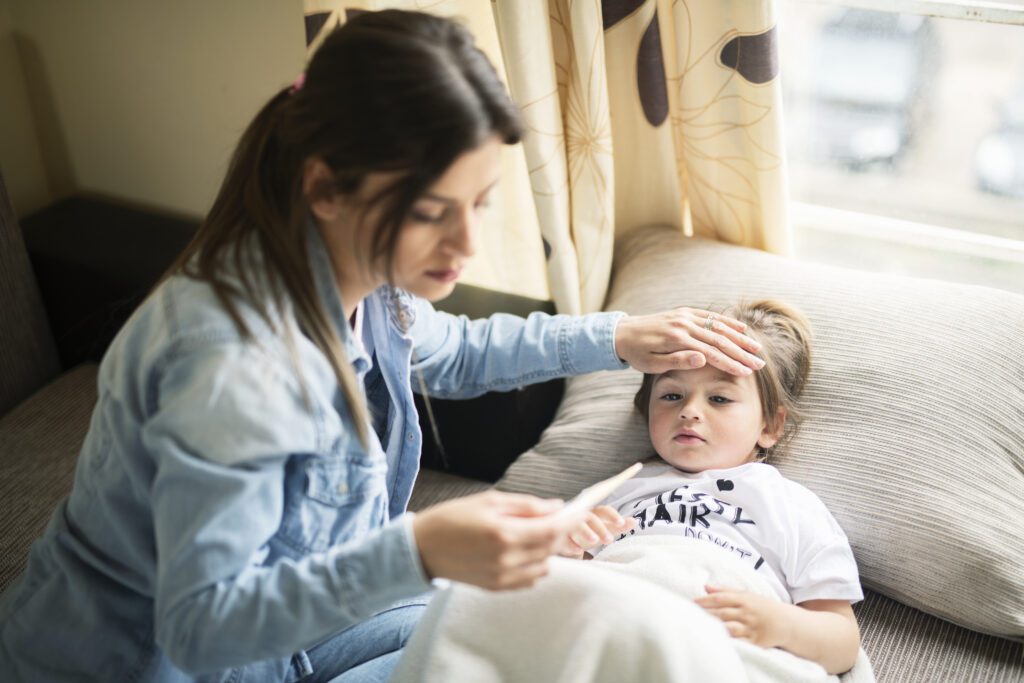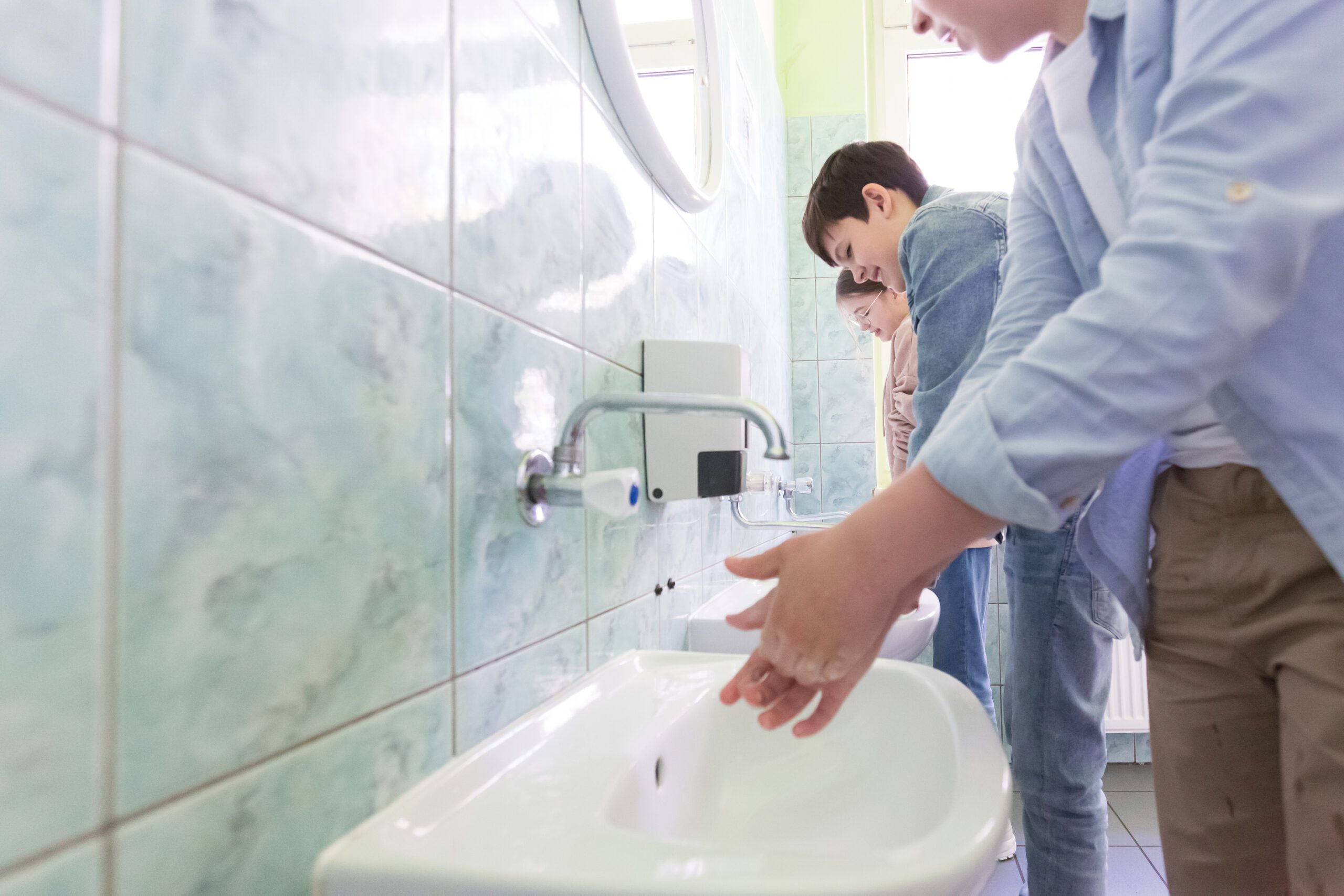Table of Contents
Respiratory illnesses like RSV, influenza, and COVID-19 have put an unprecedented number of sick children into hospitals this cold and flu season.
Hospitals are overwhelmed, pediatric units are full, and public schools are seeing a relentless stream of germs that keep on circulating between children.
- Parents are exasperated
- Kids are missing school
- Healthcare providers are burned out
Yet, there are simple hygiene safety precautions schools can take to minimize germs – and part of the solution lies in the hygiene standards in school bathrooms.
Read on to learn how communities can work together to prevent RSV, flu, COVID19 and colds in school aged children, and how the school bathroom plays a central role.
This article will teach you about:
- The rise of RSV, flu and COVID in hospitals and schools
- What’s the difference between RSV, COVID, and the flu?
- Preventing the spread of RSV, flu and COVID in schools
- Elevated hygiene to prevent the spread of germs at school and in school bathrooms


The rise of RSV, Flu and COVID in hospitals and schools
Healthcare professionals are reporting record numbers of RSV, flu, and COVID-19 this year, and some hospitals in America have even called for the president to declare a state of emergency due to rising numbers of respiratory hospitalizations.
According to the Washington Post, medical teams are seeing RSV in patients earlier than usual, and the symptoms are worse than in past years.
This has been particularly concerning in pediatric units. The sheer volume of patients coming in to be treated for RSV and other respiratory illnesses has made it extremely difficult for the families of sick children to find beds in children’s hospitals.
Working together, RSV, flu, and COVID-19 – labelled the “tridemic” by medical experts – are threatening to overwhelm a healthcare system that is already in crisis.
For those families who have been able to keep their children out of the hospital, lost work time, missed school days and back-to-back sickness have put undue pressure and stress on the whole household.


Why is RSV worse this year?
Respiratory syncytial virus – commonly known as RSV – is a respiratory virus that ordinarily creates symptoms like those of a cold or flu.
However, in serious cases, RSV is known for generating a great deal of mucus and congestion, and can cause serious infection of the lungs or breathing passages in infants and young children.
In serious cases, RSV can cause pneumonia (infection of the lungs), or bronchiolitis (inflammation of small airways in the lungs).
RSV is the most common cause of bronchiolitis and pneumonia in children under one.
Those most likely to develop infections due to RSV are infants and older adults as well as those who are immunocompromised – in much the same way that COVID-19 and the flu are most harmful for these demographics.
For those who don’t develop a serious infection, the toll of RSV can still be tough as the illness runs its course.
When it comes to why RSV is worse this year, there are a number of potential causes still being debated, including:
Regardless of the exact reason, preventing severe illness and protecting kids from too many missed days of school is something that communities can focus on to bring the circulation of viruses under control.
Read on to see how elevating hygiene in school bathrooms can help.
What’s the difference between RSV, COVID, and the flu?
Although very similar in terms of symptoms, RSV, flu and COVID are separate viruses.
Influenza, or the flu, is an annual illness that has been in circulation for as long as any of us can remember.
For many otherwise healthy people, catching any respiratory illness results in mild to moderate symptoms of respiratory sickness for about two weeks.
For others – in particular the very young, the elderly, and the immunocompromised – respiratory illnesses can lead to more severe and long-term problems with the lungs and respiratory system.
Like RSV, influenza and COVID have been known to cause pneumonia in some cases.
COVID also has the potential to cause long-term health issues like lung damage and other symptoms. This is known as long-COVID, also known as post COVID-19 condition.
Although these viruses target the same spaces (respiratory systems and sinuses), the fact that they are all different means some people may be impacted by multiple viruses at once.
Medical experts think that the triple-demic of RSV, flu and COVID will continue to rise through the new year – which is why it’s so important to take precautions to prevent the spread of illnesses to young children.


Beyond hospitalization: the impact of RSV, COVID and the flu on kids, families and schools
The tridemic has been impacting hospitals across all of North America.
In Canada – the elevated pediatric hospital admissions are creating problems for children who need urgent, life-saving treatment for illnesses or injuries that are not related to respiratory viruses.
Some Ontario hospitals have requested that adult care hospitals begin treating teenage patients ages fourteen and up, in order to clear space for younger children in pediatric hospitals.
In America, families are struggling to afford the high costs of medical bills as relentless illness drives them to hospitals to seek help for sick loved ones. Some pediatric hospitals in the US are also struggling to care for the high volume of sick children.
In both countries, families are struggling to make ends meet as many parents have had to take time off of work in order to care for sick children at home, and businesses are impacted by the high rate of sick leaves impacting revenue growth.
In some regions, colds, flu and RSV have been emptying classrooms with children and their parents taking sick time at record levels, highlighting the importance of kids’ health in the classroom.
Still, we can take steps to stop the spread of respiratory illnesses in schools by adopting better hygiene practices at home, in schools, and particularly in school bathrooms.
Preventing the spread of RSV, flu and COVID in schools
Hygiene in schools, daycares, and child-led facilities is of the utmost importance.
While it is common and normal for young children to acquire childhood illnesses such as the common cold, it’s important to protect children from dangerous respiratory viruses, unusually high circulation of viruses and so much lost time in the classroom.
Most parents would agree that minimizing the number of times their child is sick, also brings benefits such as:
- Less time off work
- Less disruption to the daily routine
- Fewer sleepless nights
- Decreased stress
- Protecting vulnerable or at-risk family members
- Reduced risk of cancelling special plans or vacations
The first step to reduce the spread of viruses is teaching children proper hygiene habits, such as hand-washing, hand-drying, and coughing or sneezing into their elbows to contain the spread of germs.


Don’t miss: We’ll tell you why how you dry your hands matters to prevent the spread of germs in schools – and anywhere else.
Hygiene precautions to reduce germs at schools and child care centres
Beyond teaching children proper hygiene habits, some schools, daycares, and child care centres have been taking extra precautions to prevent the spread of viruses and germs.
Six ways to elevate hygiene in school bathrooms
- Give good hygiene a hand with touchless hand soap dispensers
- Meet today’s new standards with child-friendly hand sanitizers
- Help kids breathe easier with effective and smart air purification systems
- Stop microbes from multiplying with HEPA filter filled hand dryers
- Encourage positive bathroom behaviour with automated toilet flushing systems
- Ensure school bathrooms are safe with expert disinfection services


It’s time to make personal hygiene for children a priority and easy for kids to practice.
Here are some suggestions for elevating basic hygiene practices at schools or child care centres:
- Sanitizing surfaces – especially meal tables and high-touch places like school bathroom taps, flush handles, and door knobs.
- Sanitizing toys and child-held objects such as water-bottles and utensils.
- Vacuuming and steam-cleaning carpets and rugs where germs tend to settle between play sessions.
- Mopping floors and washing unexpected places like walls and chairs.
- Providing child-safe sanitizers at regular intervals during the day to keep hands clean of germs.
- Extra supervision of toys that come into contact with mouths during play to be cleaned immediately.
- Wearing gloves and other personal protective equipment such as face masks and protective goggles.
Elevated hygiene practices to prevent the spread of germs in school bathrooms
School bathrooms are compact shared public spaces where private toilet hygiene practices happen.
From unflushed toilets to contaminated soap dispensers and bacteria infested floors, school bathrooms can be a hotbed for the transmission of infectious illnesses.
Adults avoid public washrooms for a number of reasons. Some kids avoid using school bathrooms for the same reasons.
Yet, with the right washroom technology, school bathroom hygiene standards and personal hygiene education for children, we can slow down and even stop the spread of sickness in schools.
Six ways to elevate hygiene in school bathrooms
Schools, daycare facilities, and child-focused activity centres can elevate hygiene protocols and practices in their bathrooms by adding these six steps to their bathroom maintenance and management checklists:
- Give good hygiene a hand with touchless hand soap dispensers
- Meet today’s new standards with child-friendly hand sanitizers
- Help kids breathe easier with effective and smart air purification systems
- Stop microbes from multiplying with HEPA filter filled hand dryers
- Encourage positive bathroom behaviour with automated toilet flushing systems
- Ensure school bathrooms are safe with expert disinfection services
By investing in simple and proven prevention practices in school bathrooms, schools, children and their families can breathe easier with fewer respiratory viruses and less lost sick time.
Take virus prevention to a higher standard
Citron Hygiene is here to help schools and other businesses combat the spread of viruses especially in school bathrooms.
Upgrading your school bathroom hygiene is simple, with our all-in-one servicing which includes:
- The installation and maintenance of touch-free technology in school bathrooms
- Flexible service schedules and consistently clean systems
- Expert care and and reliable servicing from certified hygiene technicians
It’s time to make personal hygiene for children a priority and easy for kids to practice.
Reach out to our friendly staff today to get a free consultation – and a free trial, too!
See also: keep students in school this year by creating period positive washrooms!
